Mike Vardy's Blog, page 57
September 4, 2017
Relative Productivity with Joanne Ling & Tracey Fry
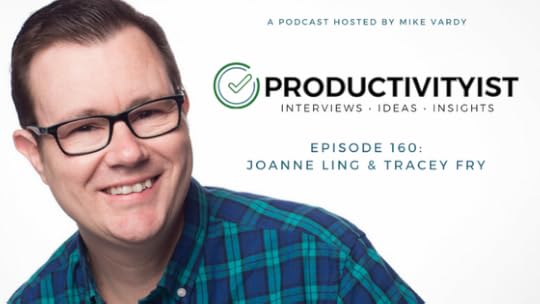
I welcome Joanne Ling and Tracey Fry from Sister Mixin’ to the show this time around. I met these two sisters at Chris Drucker’s Tropical Think Tank in March 2017 and we had a great time learning and spending time with a ton of like-minded people over the course of the event.
We discussed a variety of topics during this episode including decision-making, delegation, planning, elimination of tasks and things that aren’t working for you, and what it’s like for two siblings to run a business together across the miles.
Relevant Links:
Sister Mixin
Listen to my appearance on the Sister Mixin’ podcast!
Anne Vardy on The Whole Circle podcast
The Art and Science of Trusting Your Gut | Inc
Ego is the Enemy by Ryan Holiday | Amazon
Youpreneur Summit
Additive Free Made Easy
Thanks for tuning in! Until next time, remember to stop guessing…and start going.
If you’re interested in supporting the podcast and receiving exclusive content while doing so, you’ll want to check out the patrons-only version of The Productivityist Podcast on Patreon. Also, remember to leave The Productivityist Podcast a rating and review on iTunes, or on whatever platform you’re listening to. I read every single bit of feedback we receive. I want to make this show better and with your help I can do that.
The post Relative Productivity with Joanne Ling & Tracey Fry appeared first on Productivityist.
August 28, 2017
Szen Zone with Gary Szenderski
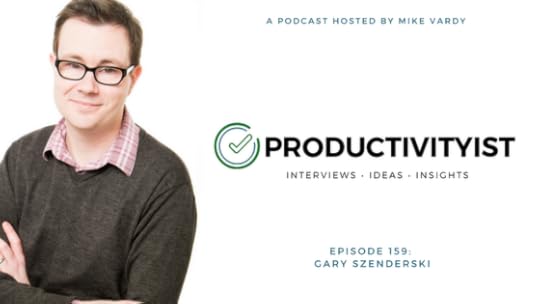
On this episode of the podcast, I speak with Gary Szenderski. Gary is the author of the book Szen Zone: Reaching a State of Positive Change and I wanted to dive into the idea of what “Szen” is why he is so fascinated with change.
Other areas we explored during our conversation include his thoughts on getting stuck and how to escape a state of “stuckness,” the idea of negative change and how it can affect us in the short and long term, tapping into awareness, and – one of my favorite discussion points – boundaries.
Related Links
Szen Book | The Szen Zone
Szen.US: Marketing Solutions for a Changing World
Gary Szenderski (@GarySzenderski) | Twitter
I had a great time chatting with Gary and we dove into his work even deeper on an exclusive episode for Productivityist patrons. You can learn more about what you can receive by becoming a patron by clicking here.
Thanks for listening.
The post Szen Zone with Gary Szenderski appeared first on Productivityist.
August 21, 2017
Worth It with Amanda Steinberg
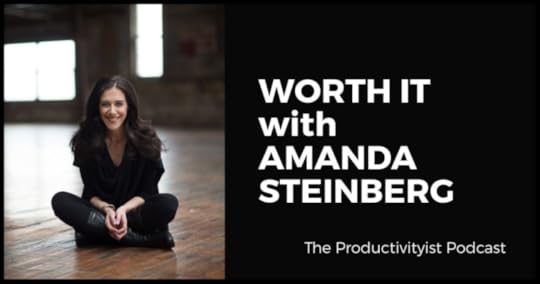
On this episode of the podcast, I speak with Amanda Steinberg. Amanda launched DailyWorth in 2009 to bring a fresh voice and an outsider’s perspective to personal finance and the Daily Worth website has made Forbes’s 100 Best Websites for Women three years running.
Amanda has appeared on Good Morning America, Today, CNN, and MSNBC, among others. Forbes named her one of the twenty-one New American Money Masters, Oprah Winfrey chose Steinberg for her inaugural SuperSoul 100 list, and Fast Company calls Steinberg one of 2017’s “Most Creative People in Business.”
We not only dive into the correlation between time and money but also discuss the relationship that people can have with the finances – particularly the relationships that women can have with money. In fact, that idea is explored in her book, Worth It: Your Life, Your Money, Your Terms. Automation and delegation come into the conversation as well, how to teach kids about the value of money early on, and other great tactics and tips that you can use to improve your relationship with money.
Relevant Links
Daily Worth
Worth It: Your Life, Your Money, Your Terms
Your Money Type Online Assessment
Money Clarity
Amanda Steinberg | Facebook
@AmandaSteinberg | Twitter
After taking the Money Type assessment I found I was an Epicure with my finances. I’m not surprised. But now I have a means to be more productive with my money thanks to some of what Amanda shared in this episode. I encourage you to take the test and see where you land in the spectrum.
Thanks for listening. If you enjoyed the show don’t forget to subscribe so you don’t miss a single episode. Until next time remember to stop guessing…and start going!
If you’re interested in supporting the podcast and receiving exclusive content while doing so, you’ll want to check out the patrons-only version of The Productivityist Podcast on Patreon. Also, remember to leave The Productivityist Podcast a rating and review on iTunes, or on whatever platform you’re listening to. I read every single bit of feedback we receive. I want to make this show better and with your help I can do that.
The post Worth It with Amanda Steinberg appeared first on Productivityist.
August 17, 2017
How to Be Productive When You’re Sick and Tired

We can’t be running at 100 percent for 100 percent of the time. We need time to rest, recuperate, and recharge.
There will be days when we feel under the weather (or worse). There will be days when we are wiped out from what the world has presented to us. We still have to show up, and, as Steven Pressfield says, “Do the work.”
If you don’t have a safeguard in place – some kind of framework to guide you through these days – then you’ll spend time cherry picking tasks at random and do far less than what you could do. Then when you’re feeling better, the tasks from those “less than optimal” days will have piled up and left you overwhelmed for the next several days ahead.
My aim with this piece is to share with you the simple strategy I’ve used (and still use) to stay productive when I’m sick and tired.
Here it is: The best thing I’ve done to keep me moving forward even when I’m not at my best is to filter my to do list tasks by energy level required.
Diving into Energy Levels
I tag many of my tasks with Energy-Based Modes so I can easily see what tasks require more energy than others. There are certain tasks that I know take more mental and physical focus. Here are some examples of tasks that require high levels of energy.
Writing a blog post
Writing a newsletter
Writing a film script
Learning anything new
Planning things
Research work
All of these tasks have been labeled or tagged with a term that signifies that it will take a lot of energy to work on them. I’ve tried several variations of terms, including the following:
High Energy
Deep Work
Full Focus
Primetime
You should choose a word or term that works best for you – something that will trigger you to work on that type of task. (Right now I’m using the term “Deep Work” because it not only represents an Energy-Based Mode for me but a Theme-Based Mode as well.)
If you want to learn more about TimeCrafting and Mode-Based Work, then check out The Productivityist Playbook. You can learn more about this digital product consisting of written, audio, and video materials here.
I never tackle these tasks whenever I’m tired or sick. I have many other tasks to choose from (often defined by the Daily Theme and then followed by one of the other categories of modes I have built and fostered over time). But I always look to low energy tasks as the first option whenever I’m sick or tired.
In fact, sometimes I’m able to dive right into the lowest energy tasks and simply work on those throughout the day. Tasks that fall into this mode include:
Reading fiction
Writing social media posts
Scanning receipts
Reviewing training materials on stuff I’m already learning
Listening to podcasts
Watching things in my Netflix queue
These tasks take very little bandwidth for me to accomplish. By labelling them as low energy tasks, I’m able to still get things done when I’m not at my best. Additionally, these are tasks that I’ve predetermined as tasks I need and/or want to do, so I’m still following through on my intentions and paying attention to them in the right way.
If you’re looking for a way to classify these tasks so that they stand out as lower energy tasks, here are some ideas:
Low Energy
Shallow Work
Brain Dead
Downtime
Some of the tasks I’ve listed as lower energy ones might seem inconsequential to you. An example of this would be watching things in my Netflix queue. But if you’ve read my piece on Netflix productivity then you’ll understand that by having this task in my to do list, I’m able to recognize it anytime (whether I’m sick, tired, or otherwise) as an intention and I have put in place great way to pay attention to it as well.
Now let’s explore how to categorize tasks in this fashion using various platforms and methods of keeping a to do list.
How to Do This in Popular To Do List Apps
Being aware of what tasks take less energy than others is all well and good, but you don’t want to have to try to remember this information when you are sick and tired. You want to be able to look at your to do list and simply see what ones do. A powerful to do list app can help you do that.
While you can use Reminders on iOS to do this (by creating lists related to energy), it’s not exactly a powerhouse to do list app. There are plenty of other apps that fit the description to a powerful to do list app, but I’m going to focus on the three that I use most in my client work: Asana, Todoist, and Trello.
Asana
The best way to illustrate what tasks take different levels of energy is to use tags in Asana. You can either create tags that are the same colour to indicate energy level and use different colours for each type of category of mode (theme-based, resource-based, activity-based, and time-based). If you’ve not explored TimeCrafting’s aspect of mode-based work yet, then you can use one colour for the high energy tag and another for the low energy one. Try to use colours that are indicative of the type of energy if you do this – so choosing a vibrant colour for high energy and a drab one for low energy would work well.
The great thing about using tags for this type of filtering is that you can create a favorite with the tag so it shows up in your upper left sidebar. To favorite a tag, simply click on it in a task and then star it when you are in that view (as shown below).

If you’re using a paid tier of Asana and want to leverage the power of custom fields, then you may want to create one for energy levels. This will allow you to sort tasks with the custom field instead of the tag view. (I’d use this method if you already have a lot of tags per task and you’re not really using custom fields all that much – or if you want your team to start using energy-based modes to work through their to do list.)
Todoist
I use Todoist for my own work these days and use Asana for all of the Productivityist team tasks. So it’s really important that I filter out tasks by energy level in this app. I do this by creating labels for the different types of modes I need or want to work in and my energy-based modes. (Deep work and shallow work – are my most-used labels.)
I use the colour green for my energy-based modes and only have two labels for them: DeepWork and ShallowWork (stylized this way because Todoist puts an underscore where spaces between words would be). The majority of my tasks in Todoist has one of these labels attached to them. I only use these two energy types for labels because anything that doesn’t require high or low energy is not easily identified as something to work on based on my energy levels. I want polar opposites with energy-based mode labels. It removes most of the guesswork that I could get stuck on.
I use filters like crazy in Todoist. Two of my filters are query-based and they both present me with a view of my deep work over the next 15 days and my shallow work over the next 15 days.
Here’s my Deep Work filter:
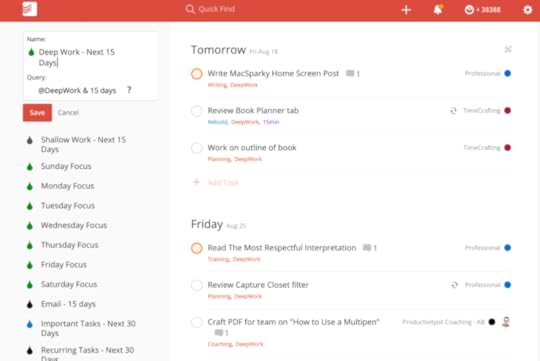
And here’s my Shallow Work filter:
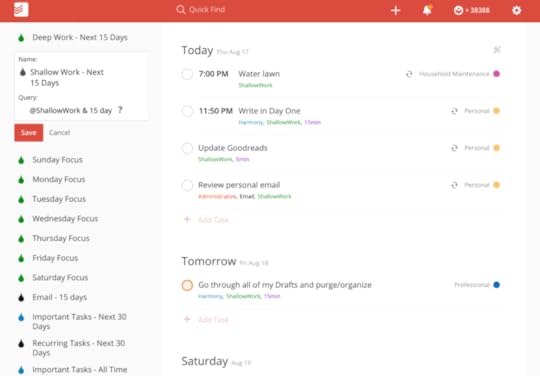
I could expand that view to 30 days if I want, but I’ve found that seeing a good half-month view of my tasks based on these kind of parameters strikes a balance that fits me just right. The great thing about filters in Todoist is that they re incredibly customizable and you can personalize them to the way you need and/or want to work.
(I actually work by my list of filters 90 percent of the time. If you’re interested in hearing how and why I do this, drop me a line at askmike@productivityist.com and I’ll be happy to dive deeper into that with you personally.)
Trello
Trello is arranged a bit differently than the other two apps that I’ve mentioned (although Asana now has boards as an initial project view as well) but that doesn’t mean you can’t set things up in a way that allows you to view your tasks by how much energy they will take to complete.
One way to do this is by using labels. That said, Trello’s labels are a different animal than Todoist’s. For example, Trello doesn’t allow you to add labels to anything other than cards. That means that if you want to view tasks by label in Trello, you need to treat cards as tasks.
If you’d rather use the labels for something else in Trello, then you can set up your list in Trello to use cards containing tasks organized by energy level. I’ve shown you how to do this below in the High Energy card for my Flagship Course project in Trello.
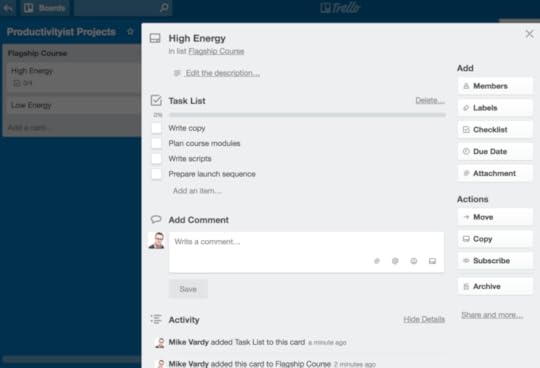
As you can see, each card here represents a mode of some sort based on the categories of modes I use in my TimeCrafting methodology. Each list is a project, and each card is a mode that I use. Each checklist inside the mode-based cards contains tasks that I’ve classified as low energy or high energy. The same can be said for the checklists inside of the other mode-based cards (Admin, Audio, Video, etc.). This is not a traditional Trello setup, but if you want to use the checklist feature in Trello to easily identify tasks by energy level, this is a great way to do it.
Why Energy Levels Matter
If you want to deliver results with quantity AND quality in mind, then paying attention to your energy level matters. When you connect tasks by the amount of energy required, you can put your best foot forward and maintain that footing throughout. You only need look inward as to how you’re feeling and then outward as to what tasks are best suited to be worked on based on that feeling.
That’s not only a more productive way to look at your to do list – it’s a more personal one too. You’ll spend more time with it, and that makes it a better to do list for you.
The post How to Be Productive When You’re Sick and Tired appeared first on Productivityist.
August 14, 2017
Get That Job with Angela Copeland
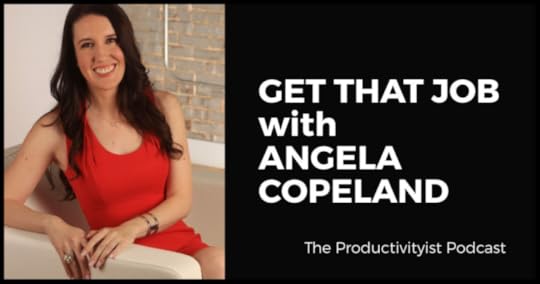
On this episode of The Productivityist Podcast I welcome guest Angela Copeland. Angela is a career coach and CEO at her firm, Copeland Coaching. She is the host of the Copeland Coaching Podcast, columnist for the Career Corner newspaper column, and author of career book Breaking The Rules & Getting The Job.
Angela’s personal career background gives her the breadth to help job seekers with a variety of different needs, including finding the right job, interviewing, and offer negotiation.
The primary goal of the conversation was to dive into how to make career changes as productive as possible. The whole process is something we touch on (the search for the new career, the frequency you should look for new career opportunities) and how to go about breaking the rules along the way.
Relevant Links:
Copeland Coaching
Breaking The Rules and Getting The Job | Amazon
Angela Copeland | Twitter
Thanks for tuning in! Until next time, remember to stop guessing…and start going.
If you’re interested in supporting the podcast and receiving exclusive content while doing so, you’ll want to check out the patrons-only version of The Productivityist Podcast on Patreon. Also, remember to leave The Productivityist Podcast a rating and review on iTunes, or on whatever platform you’re listening to. I read every single bit of feedback we receive. I want to make this show better and with your help I can do that.
The post Get That Job with Angela Copeland appeared first on Productivityist.
August 10, 2017
The Myth of Perfect Focus
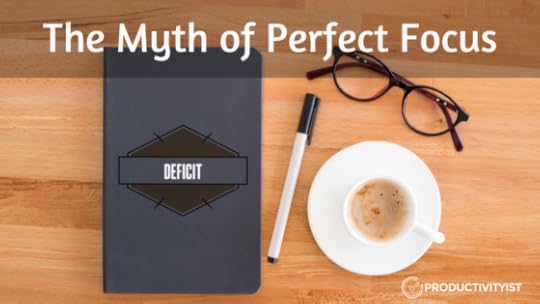
When you’re on the ball and the path is clear as to what you’re doing and why, you’re in a state of focus.
When you’ve dropped the ball and the path is littered with stuff that you’re not even sure why you’re doing, you’re in a state of non-focus.
The thing is, there’s no such thing as having perfect focus. That’s because there’s no such thing as the perfect thing for you to do, the perfect way for you to do it, and the perfect time for you to do it.
That’s why you need to embrace “imperfect focus”. It can be a huge ally in your life.
Once you embrace imperfect focus, you’ll be able to figure what you want – and don’t want – a lot easier. This is because you already understand that the choices you make will never be perfect.
The post The Myth of Perfect Focus appeared first on Productivityist.
August 7, 2017
OmniFocus and Other Things with Joe Buhlig
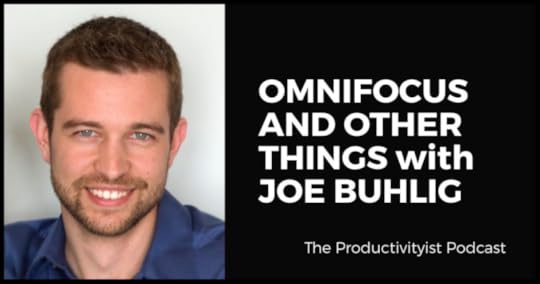
Joe Buhlig and I sit down this week to talk about an app that he uses extensively: OmniFocus. But we don’t stop there. We talk about a ton of other things, including:
Paper-based productivity and where it fits into his workflow
The new version of Things by Cultured Code
Why you should consider paying for task management apps
Joe’s a productivity powerhouse (as you would have noticed if you listened to his earlier appearance on one of the show’s bonus episodes – search back through the archives and you’ll find that episode) and I really enjoyed diving deeper into the technical and app-oriented stuff this time around. I hope you did too.
Relevant Links
OmniFocus
Working with OmniFocus
Things | Cultured Code
Joe Buhlig | Twitter
Thanks for tuning in! Until next time, remember to stop guessing…and start going.
If you’re interested in supporting the podcast and receiving exclusive content while doing so, you’ll want to check out the patrons-only version of The Productivityist Podcast on Patreon. Also, remember to leave The Productivityist Podcast a rating and review on iTunes, or on whatever platform you’re listening to. I read every single bit of feedback we receive. I want to make this show better and with your help I can do that.
The post OmniFocus and Other Things with Joe Buhlig appeared first on Productivityist.
August 3, 2017
The Shut Up Strategy
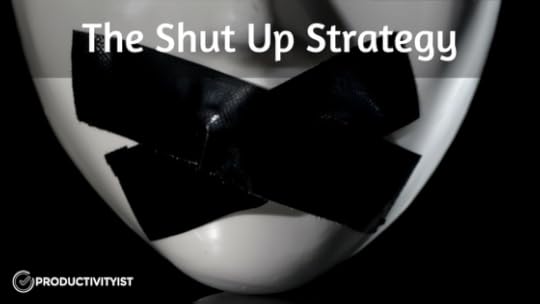
A few weeks ago, I shared a post from Austin Kleon called Just shut up and write the book. This post reminded me of a video by Derek Sivers. I had the opportunity to meet Derek at World Domination Summit, a couple of years ago. He talked about not sharing your goals and that there’s some science behind like keeping those things to yourself.
A couple of months ago, I spoke with Jeff Goins. Jeff shared with me a story about J. R. R. Tolkien and C. S. Lewis. Tolkien had never really shared his work before. The first time he did it with his friend C.S Lewis.
I think there’s some merit to that. We live in an era where talking about what we’re doing, or what we’re going to do, seems to indicate that you are actually doing the thing. That’s not necessarily the case. I’ve fallen victim to that too. Whether it’s been through announcing something that I’m going to do and then taking forever to get to it because I didn’t properly assess what else was going on. And I think that we see a lot more of this. We see it with pre-launches and on social media. But we don’t know everything that goes on behind the scenes.
But there’s advice like create a sales page, validate your idea, and then make it. I think that there’s merit to that, but I think the problem is that we live in an age where when you do that, it’s almost assumed – especially when you have a large following – that you’re going to make that thing. The Shut Up Strategy that I’m talking about is keeping certain things quiet to yourself.
What I will say is that if you’re going to talk about something that you’re doing, keep it to the one thing that you’re doing. So for me, The Shut Up Strategy involves the bigger things that you have a sliver of hesitation to share. You’re not sure if it’s going to be something that can be delivered in a reasonable timeframe, or it may even change or iterate before it gets released.
I got that recently when I went to Tropical Think Tank. I had people who told me, “Oh, you should build a course.” My reply was, “Yes, I am working on some courses, and I definitely have the content to do it.” In fact, as you’re reading this, I may even be closer to that being a reality. But when you start to share that stuff, an expectation comes with it. When you share too often, some expectations fall short and don’t happen.
There’s something to be said for diving in deep to do the actual work. Not talking about it, just doing it. Then the work speaks for itself when it’s done. I know that I’ve struggled with this.
Try to incorporate The Shut Up Strategy more often. If you’re finding that you’re talking about the stuff you’re doing, and it’s not moving along as quickly as you would like it to, spend time doing the work. Again, less talk, more action. The Shut Up Strategy can be incorporated in many different ways, but maybe, for now, I think I’m just going to shut up and let you think about what you can do to incorporate it.
The post The Shut Up Strategy appeared first on Productivityist.
July 27, 2017
What To Do About Procrastination
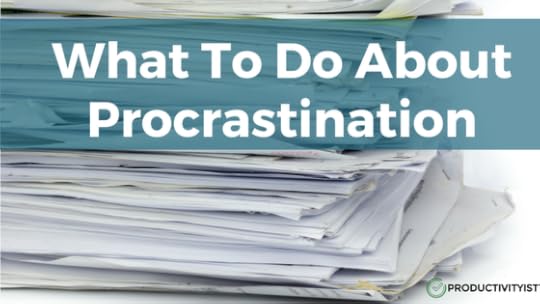
This guest post is by Camilla Kragius. Camilla is the founder of No More Hamster Wheel. She loves to teach people how to work smarter instead of harder and how to excel in life. You can connect with her on Facebook.
We all procrastinate. It’s unavoidable. But did you know that beating yourself up over your procrastination is the antithesis of productivity? It will only slow you down.
When we beat ourselves up for procrastinating, we dive into negative self-talk. Instead of giving ourselves a clean slate to start the day over, we think “Oh, I’m already screwing this up so why even bother trying now?”
That kind of negative self-talk only leads to more negative self-talk. Before you know it, your entire day has been unproductive. So whenever you find yourself participating in negative self-talk, it is important to recognize that you are doing it. Break things up by taking a walk, chatting with an upbeat friend or grabbing a healthy snack. Don’t allow your mind to continue to indulge any further in negativity.
Why We Procrastinate
Uncertainty is often the core reason behind procrastinating. Maybe the task at hand feels overwhelming. Maybe there is a lack of knowledge or training. Overwhelm can have many reasons. The way to get around the feeling of overwhelm is to break projects or tasks down into small bite sizes. Instead of thinking “This task will take me days to do,” set aside 15 minutes a day to work on the task at hand.
Often once we start doing the work, we usually find more motivation. We then realize that the work isn’t as bad as we thought. We tend to think a task is worse than it is. In our mind the task is awful, so we focus on how boring it is. These thoughts only make it more awful and boring. But when we know we only have to “suffer” for 15 minutes, then it’s mentally easier. There is a way out. No more having to work on something until it’s done–it’s only 15 minutes
More Reasons For Procrastinating
1. Perfectionism. You want everything to be perfect before you start. Since nothing will ever fit your “perfect criteria,” you procrastinate. This gives you an excuse as to why you haven’t done the work yet.
Action Step: Know that nothing is ever going to be perfect. We are our own worst critics. Be brave and take that first step.
2. Analysis paralysis. You avoid making decisions. This leads to procrastination because you do not know to do to move forward.
Action Step: Set a deadline for when you will decide. Research what you need to research and then make a decision and stick to it. Have someone keep you accountable. If it’s something simple, just toss a coin.
3. Better planning is needed. You need to spend more time with your task manager and your calendar.
Action Step: Unless you love running around frantically at the last minute, ask yourself what is one thing can you start doing to reduce the chaos in your life? Taking a few minutes to prepare things the night before is a great way to reduce stress in the morning. Even such a thing as picking what you will wear can reduce overwhelm.
4. You are afraid of either succeeding or failing. If you don’t do anything, you don’t risk either one.
Action Step: number one regret of dying people is that they didn’t live an authentic life and instead lived a “safe” life. Do you really want to have that kind of regret because of fear? We all fail and succeed…that’s part of life.
5. You are trying to do too many things. You’re in constant ‘mini-exhaustion’ mode where you are overwhelmed all of the time.
Action Step: Quit something every week or month. For every “yes” you say, you say “no” to something else. Stop doing too many things. You are no doubt a productive person. Just remember: even productive people need to rest.
There can be other reasons behind procrastination. In some cases, procrastination is not always a bad thing. Sometimes it’s good to procrastinate. Every now and then it is fine to ignore that huge pile of dishes in the sink to get a few more minutes of sleep. But also listen to why you avoid something. Are you trying to force yourself to do something just because someone said you should? Or society said you should? Try to figure out the root cause of your procrastination and then work on fixing that.
Do you know what causes you to procrastinate? Leave a comment below, and let’s start a conversation.
The post What To Do About Procrastination appeared first on Productivityist.
July 24, 2017
Cause and Connection with James Eder
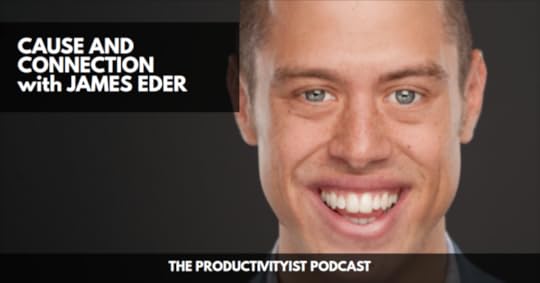
On this episode of the podcast, I am joined by James Eder, the founder of a new social app called Causr. James shares insights about connecting with others and the role social interaction plays in our lives.
Some of the takeaways from our conversation include:
We’re social beings. If we can give people context and understand who is nearby, connection–and even community–can form.
The importance of face-to-face conversations–especially at conferences.
There’s an energy in real-life interaction; that’s why people still attend conferences. You could probably access all the information online, but interacting in-person takes relationships to a deeper level.
Make use of your travel time.
Between 30% to 60% of your time traveling is actually used for work and the rest is downtime. Instead of interacting only online, you can use time in an airport to connect with others around you.
the idea of net giving versus networking.
Ask “How can I help other people?” instead of “What’s in this for me?” when attending networking events.
Relevant Links
Causr – Connect with people near you now
Q&A with Causr founder and CEO James Eder | SmartBrief
James Eder | Twitter
Read the transcript of this episode here
Download the transcript of this episode here.
Thanks for tuning in! Until next time, remember to stop guessing…and start going.
If you’re interested in supporting the podcast and receiving exclusive content while doing so, you’ll want to check out the patrons-only version of The Productivityist Podcast on Patreon. Also, remember to leave The Productivityist Podcast a rating and review on iTunes, or on whatever platform you’re listening to. I read every single bit of feedback we receive. I want to make this show better and with your help I can do that.
The post Cause and Connection with James Eder appeared first on Productivityist.



